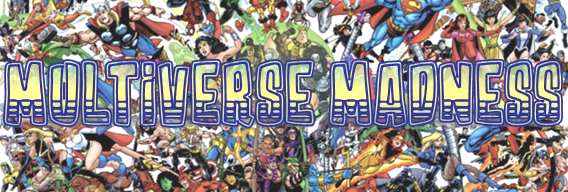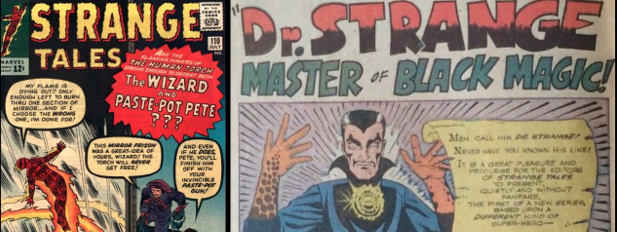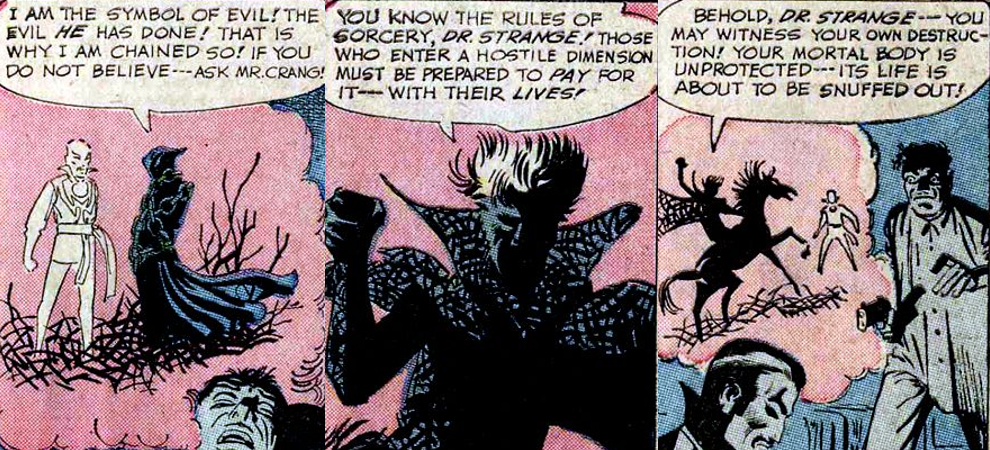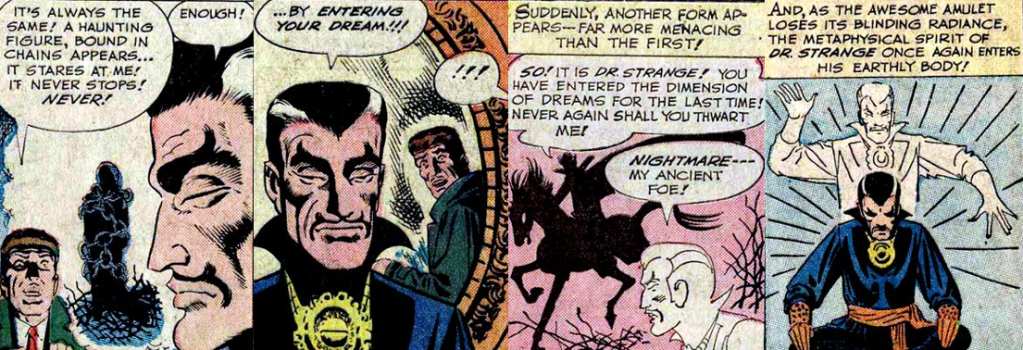In September 1961, DC Comics published “Flash of Two Worlds” (Fox, et al), a landmark story that brought together two generations of the Flash: the Golden Age Jay Garrick and the Silver Age Barry Allen thanks to the concept of the multiverse, an infinite number of parallel universes that allowed any and all stories and characters to co-exist and interact. Marvel Comics would also adopt this concept and, to celebrate the release of Doctor Strange in the Multiverse of Madness (Raimi, 2022) this month, I’ll be both celebrating the Master of the Mystic Arts and exploring the Marvel Cinematic Universe’s (MCU) equivalent of the multiverse every Sunday of May.
Story Title: “Doctor Strange, Master of Black Magic!”
Published: 9 April 1963 (cover-dated July 1963)
Writer: Stan Lee
Artists: Steve Ditko
The Background:
Dr. Strange began life as the brainchild of legendary artist Steve Ditko, when he submitted a five-page pitch for a new type of character, one who dabbled in black magic, to the immortal Stan Lee. The character was so named as he was to debut in the pages of Strange Tales, a Marvel Comics anthology title that initially published horror tales, and it was Lee who infused the character with many of his more elaborate spells and quirks. Known for his surreal visuals and bizarre adventures, Dr. Strange has since become one of Marvel’s most pivotal figureheads. The Master of the Mystic Arts has been at the centre of many of Marvel’s most important stories and remains one of their most powerful characters, and has even successfully crossed over into the mainstream thanks to featuring in various videogames, cartoons, and the MCU.
The Review:
The story begins with a man being tormented by horrific nightmares as he sleeps; presumably having tried every solution to no avail (though there’s no actual in-comic evidence of that), he seeks out the help of the mysterious Dr. Strange, a man rumoured to practise the dark arts, in order to ease his torment. The next morning, he arrives “on a quiet street in New York’s colourful Greenwich Village” at the fantastic home of the aforementioned doctor, and begs for his help. The man tells of a haunted figure, bound in chains, who incessantly glares at him in his dreams, and Strange immediately pledges to visit him that evening and discover the answer by entering the man’s slumbering mind!
Before this, though, Dr. Strange indulges in a bit of meditation where he separates his soul (or “metaphysical spirit”) from his physical form and effortlessly travels through walls and across vast distances to “a hidden temple somewhere in the remote vastness of Asia” where his wizened master dwells. The old man warns Strange of a darkness that threatens him and urges him to be cautious as Strange is set to succeed the elderly wizard as the defender against the forces of evil. Dr. Strange heeds the warning, and promises to depend upon his magical amulet when under threat, and makes good on his promise to visit the man and enter his nightmare using his metaphysical spirit form.
In the desolate void of the dream world, Strange encounters the figure tormenting the man and demands answers. The cloaked spirit claims to the symbol of the evil this man has done to a “Mr. Crang”, but their conversation is quickly interrupted by the arrival of a caped, shadowy figure on horseback, one far more menacing and known all-too-well to Dr. Strange. The entity is Nightmare, a being of darkness and chaos, who vows to make Strange pay for entering the hostile dream dimension once more. As Dr. Strange’s physical body is left helpless and in a trance, the sleeping man awakens and, keen to keep Strange from revealing what he knows about Mr. Chang, pulls out a gun and prepares to murder the sorcerer on Nightmare’s bidding!
However, Dr. Strange isn’t left entirely helpless; he calls out to his master for aid and, from half a world away, the elderly wizard manipulates the mysterious golden amulet around Strange’s neck. The trinket glows brighter and brighter, revealing “a fantastic metal eye […] such as no mortal has ever beheld” and, upon seeing this strange eye, the would-be gunman freezes on the spot and is left immobile. This is all the distraction Strange needs to easily dart past Nightmare and return to his body, though his shadowy foe vows to have his revenge one day. Upon returning to the physical world, Strange compels the man to speak the truth and he finally reveals that his nightmares were caused by all the robberies he committed against other businessmen. The story ends with Dr. Strange urging the man to confess to his crimes as it’s the only way he’ll be able to sleep and thus ends the…less than thrilling first appearance of the Master of the Mystic Arts.
The Summary:
“Doctor Strange, Master of Black Magic!” is very clearly a back-up tale in a comic book featuring a bunch of different short stories and, as a result, is a brisk little episode simply designed to introduce this quirky new character to Marvel’s readers. We really don’t learn a whole hell of a lot about anything going on here; we don’t even learn the name of the man being haunted by Nightmare let along any background on Dr. Strange, his origin, or his motivations. Even Dr. Strange’s powers are vague, at best, with the focus of this first story being solely on his ability to astral project and enter dreams to help others. His magical amulet isn’t named or explained beyond being this mystical artefact and a lot of the familiar trappings either aren’t really here or are ill-defined compared to what you might expect from the character.
The story itself is incredibly simplistic, which is most likely due to how few panels and pages were allotted to tell the tale, and there’s definitely a lot of questions left hanging in the air for subsequent stories to fill us in on, which is a refreshing change from other superhero debuts that bombard the reader with nothing but exposition. “Doctor Strange, Master of Black Magic!” is arguably too vague, though, but it’s definitely very intriguing; Dr. Strange isn’t really positioned as a superhero in the traditional sense and is, instead, more of an enigmatic consultant for ailments and supernatural occurrences. The real standout here is the art, particularly regarding Dr. Strange’s character design; while the backgrounds and locations aren’t that interesting (the dream dimension is basically an empty void), Dr. Strange is colourful and eye-catching and I enjoy how he gives off a wise, almost condescending authority that would become so synonymous with the character going forward. The hooded figure and Nightmare are intriguing malicious forces representing guilt, sin, and chaos but they’re very vaguely defined, so it’s pretty easy for Dr. Strange to steal the show. It’s just a shame that he basically spends the entire story either standing around or sitting down in a trance rather than doing something more interesting, like casting spells or spewing out nonsense incantations.
My Rating:
Could Be Better
Have you read “Doctor Strange, Master of Black Magic!”? Do you own a copy of Strange Tales #110? What did you think to the story and the mystery surrounding Dr. Strange? Do you think that the tale needed a few more pages to tell a bit more of his story or did you enjoy the intrigue surrounding Dr. Strange and Nightmare? What are some of your favourite Dr. Strange stories and who is your favourite villain of his? Do you enjoy multiverse shenanigans in comics or do you find them to be overly complicated? Whatever your thoughts on Dr. Strange, sign up to drop a comment down below or let me know on my social media and check back next Sunday for more Multiverse Madness from the Sorcerer Supreme.








2 thoughts on “Back Issues [Multiverse Madness]: Strange Tales #110”